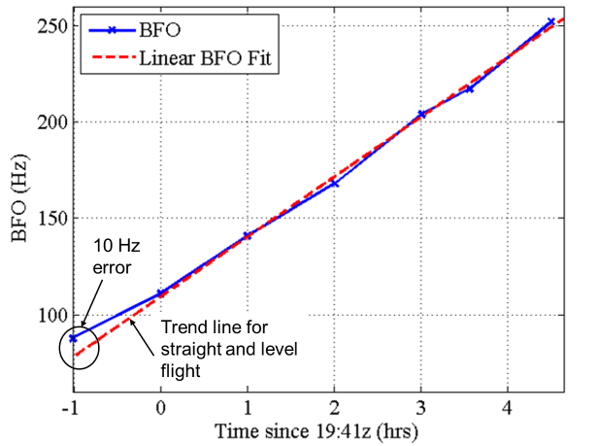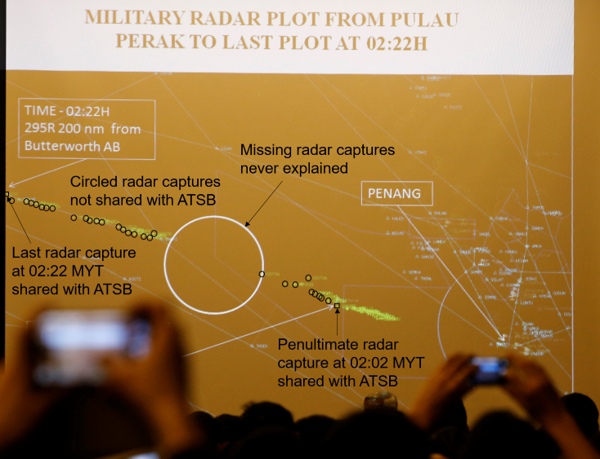In the past week, there were two serious technical papers released that discuss evidence surrounding MH370 and with implications on where it may have crashed along the 7th arc. The two papers demonstrate that there is still significant disagreement about how to interpret some critical technical data.
In the first paper, entitled “The Probable End Point of MH370”, IG member Richard Godfrey concludes that MH370 most likely crashed along the 7th arc at 30S latitude, which is well north of where the seabed was searched. Richard uses the extensive drifter data from the Global Drifter Program to develop a comprehensive drift model. He organizes and analyzes the drifter data, which includes the position, speed, direction, and water temperature measured by the drifters at 6-hour intervals, and he groups the data by position and calendar month. By introducing an “efficiency factor”, Richard relates the straight-line distance traversed by a drifter over 60 days compared to the total path length calculated from the 6-hour data and integrated over the same 60 days. Richard uses the derived speeds, directions, and efficiency factors to estimate the trajectory of debris that originates from the 7th arc in March. By incorporating the variability of efficiency factor that was experienced by the drifters, Richard calculates and presents the considerable dispersion of debris released from the same starting position along the 7th arc. Richard also relates the predicted temperature history of the debris to the observed barnacle populations on the debris. Richard concludes:
The drift analysis appears to support a probable end point of MH370 around 30°S near the 7th Arc. This fits with a late final major turn south at 19:36 UTC and a flight at the normal cruise speed of 0.84 Mach until fuel exhaustion. There is a good fit to the satellite data and a good fit to a great circle path toward Wilkins Runway (YWKS) as the final waypoint.
The drift analysis also explains the reason why MH370 floating debris originating around 30°S near the 7th Arc could end up in Reunion and South Africa with barnacles via tracks that pass through sea water between 19°C and 25°C and end up in Madagascar, Mozambique and Tanzania without barnacles via tracks that pass through sea water above 25°C.
The second paper, authored by Ian Holland of Australia’s Defense, Science, and Technology Group (DSTG), is entitled “The Use of Burst Frequency Offsets in the Search for MH370”. The paper presents the general methods used to calculate the BFO for reconstructed paths, but the real importance of the paper lies in the conclusions drawn from the BFO sequence at three critical times, which I paraphrase as the following:
The BFO sequence at the log-on at around 18:25Z is consistent with the BFO sequence that was measured for six previous log-ons of the 9M-MRO aircraft after a power down of 35 minutes or more. For MH370, the BFO values starting at 18:25:27Z and ending at 18:28:15Z were 142, 273, 176, 175, 172, 144, and 143 Hz. The decay from 273 Hz to 143 Hz is consistent with the decay in BFO values observed six previous log-ons, while the first value of 142 Hz is not. The author advises us to reject the initial value of 142 Hz because of the lower carrier-to-noise density ratio (C/No) and the non-zero bit error for that data point, which suggests that MH370 was flying at constant speed, track, and altitude during the log-on sequence. It also implies that the statistical equivalence of the first and last values is coincidental. No attempt is made in the paper to reconcile the measured BTO sequence with this interpretation of the BFO sequence (constant speed, track, and altitude).
MH370 should lie close to the 7th arc because the BFO sequence at the final log-on at around 00:19Z is consistent with a steep descent. Two hypothetical cases were considered: A log-on after a power down of several minutes, and a log-on after the SATCOM experienced an outage of communication not related to a loss of power. Considering these two cases, and also accounting for the possible contributions to BFO error caused by the decay in BFO values after a power down and the BFO error caused by drift of the SATCOM’s oscillator, the upper and lower bounds on the descent rate of MH370 were estimated. At 00:19:29Z, the descent rate is bounded between 2,900 and 6,800 fpm. At 00:19:37Z, the descent rate is bounded between 13,800 and 17,600 fpm.
The BFO values at the time of the call attempt at 18:40 suggests the aircraft had already turned to the south. As shown in the figure below, the BFO sequence between 19:41Z and 00:11Z, inclusive, matches a trend line that is consistent with straight and level flight. If this line is extrapolated back to 18:40Z, the author says there is rough agreement with the BFO value at 18:40, which implies that at this time, the plane was already on its straight and level path to the south. The author makes this conclusion despite the approximate 10-Hz discrepancy between the trend line and the BFO value, which is left unexplained.

Measured BFO from MH370 flight showing linear trend
The two recent papers demonstrate two sensible but different interpretations of the same set of data. If we are to accept the conclusions in Ian Holland’s paper, then the range of latitudes of the underwater search area was properly defined, and the aircraft should have been found close to the 7th arc. Why the aircraft was not found remains unexplained. On the other hand, Richard Godfrey, both in his recent paper and in a previous paper he co-authored with me, challenges the assertion that the BFO at 18:40Z unequivocally demonstrates that MH370 was flying south at that time.
As we attempt to explain why the underwater search has failed, the two papers demonstrate the importance of challenging some long-held assumptions. The difference in interpretations of the two authors is yet another demonstration of why it is imperative that the authorities release all the available information related to this case.
Update on 2/18/17: The deviation from the trend line was corrected to 10 Hz.



